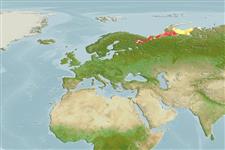Classification / Names
Common names from other countries
Main reference
Size / Weight / Age
Max length : 42.0 cm TL male/unsexed; (Ref. 1371); max. reported age: 12 years (Ref. 72462)
Environment
Marine; freshwater; brackish; demersal; amphidromous; depth range 10 - ? m (Ref. 1371)
Climate / Range
Polar, preferred -1°C (Ref. 107945); 74°N - 62°N, 33°E - 83°E (Ref. 1371)
Distribution
Short description
Dorsal
spines
(total): 0;
Anal
spines: 0. Lateral line continuous to about the origin of the second dorsal fin. Head with no lateral line pores. Expanded parapophyses swollen and hollow, beginning on about vertebral centrum 5, containing outpouchings of the swim bladder. Brownish dorsally, becoming paler ventrally; with small dark blotches.
IUCN Red List Status (Ref. 115185)
Threat to humans
Harmless
Human uses
Fisheries: commercial
More information
Age/SizeGrowthLength-weightLength-lengthLength-frequenciesMorphometricsMorphologyLarvaeLarval dynamicsRecruitmentAbundance
Tools
Special reports
Download XML
Internet sources
Estimates of some properties based on models
Phylogenetic diversity index
PD50 = 0.7500 many relatives (e.g. carps) 0.5 - 2.0 few relatives (e.g. lungfishes)
Trophic Level
4.2 ±0.73 se; Based on food items.
Resilience
Medium, minimum population doubling time 1.4 - 4.4 years (tm=3-4; Fec=20,000)
Vulnerability
Moderate to high vulnerability (50 of 100)
Price category
